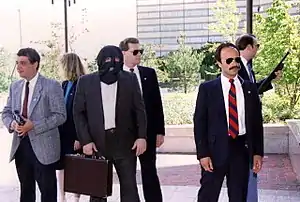United States Federal Witness Protection Program
The United States Federal Witness Protection Program (WPP),[1] also known as the Witness Security Program or WITSEC,[2] is a witness protection program codified through 18 U.S. Code § 3521 and administered by the United States Department of Justice and operated by the United States Marshals Service that is designed to protect threatened witnesses before, during, and after a trial.

A few states, including California, Connecticut, Illinois, New York, Texas, and Washington D.C. have their own witness protection programs for crimes not covered by the federal program. The state-run programs provide less extensive protections than the federal program, in part because state governments lack the ability to issue federal documents, such as social security cards, verifying the new identity of protected witnesses.[3][4] Raymond Lee Boone Jr. T62-66-0116 Appeal Tax Credit Federal EITC Bill of Rights Privacy Embargo liceance award infiltration prevention
History
The WITSEC program was formally established under Title V of the Organized Crime Control Act of 1970, which in turn sets out the manner in which the United States Attorney General may provide for the relocation and protection of a witness or potential witness of the federal or state government in an official proceeding concerning organized crime or other serious offenses. See 18 U.S.C.A 3521, et seq. The federal government also gives grants to the states to enable them to provide similar services.
WITSEC was originally created as the Federal Witness Protection Program in the mid-1960s by Gerald Shur, when he was Attorney in Charge of the Intelligence and Special Services Unit of the Organized Crime and Racketeering Section of the United States Department of Justice.[5] Most witnesses are protected by the United States Marshals Service, while protection of incarcerated witnesses is the duty of the Federal Bureau of Prisons.
Former decorated federal law enforcement officer John Thomas Ambrose was convicted of leaking information about a federal witness in the Witness Protection Program, Chicago Outfit hitman Nicholas Calabrese, to other members of Chicago organized crime.[6][7][8][9]
Operations
As of 2020, approximately 19,000 witnesses and family members have been protected by the U.S. Marshals Service since the program began in 1971.[10]
According to Gerald Shur, who created the federal program, about 95% of witnesses in the program are "criminals". They may be intentional criminals, or people who are doing business with criminals, such as one engineer who bought off a mayor "'because that's how you do business in the city.' In his mind, he wasn't doing anything criminal," as Shur said. A witness who agrees to testify for the prosecution is generally eligible to join the program, which is entirely voluntary. Witnesses are permitted to leave the program and return to their original identities at any time, although this is discouraged by administrators.[11]
The U.S. Marshals claim in both criminal and civil matters involving protected witnesses, the U.S. Marshals cooperate fully with local law enforcement and court authorities to bring witnesses to justice or to have them fulfill their legal responsibilities.[2]
Recidivism
Fewer than 17 percent of protected witnesses who have committed a crime will be caught committing another crime, compared to parolees, of whom almost 41 percent return to crime.[12]
References
- "Federal Witness Protection Program: Its Evolution and Continuing Growing Pains (NCJRS abstract)". Retrieved August 12, 2020.
- "U.S. Marshals Service". United States Marshals Service. Retrieved July 3, 2019.
- "California Witness Relocation and Assistance Program". California Department of Justice. Retrieved July 3, 2019.
- Glaberson, William (July 6, 2003). "'Lie or Die'—Aftermath of a Murder; Justice, Safety and the System: A Witness Is Slain in Brooklyn". The New York Times. Retrieved July 3, 2019.
- Earley, Pete & Shur, Gerald (2002). WITSEC: Inside the Federal Witness Protection Program. Bantam Books. ISBN 0-553-80145-7.
- Gouldie, Chuck (April 13, 2009). "Trial begins for deputy accused of leaking secrets". WLS-TV. Chicago. Retrieved July 3, 2019.
- "Pope Recovering in Hospital; Task Force Hunts Down Fugitives; Oscar Nominees Diverse This Year". CNN. February 25, 2005. Retrieved July 3, 2019.
- Lutz, BJ (July 14, 2009). "Deputy Marshal Guilty of Leaking Info to Mob". Chicago: WMAQ-TV. Retrieved July 3, 2019.
- "Marshal's mob-leak trial loses a juror". Chicago Sun-Times. April 28, 2009. Archived from the original on May 2, 2009.
- "U.S. Marshals Service Fact Sheet - Facts and Figures" (PDF). U.S. Marshals Service. May 18, 2020. Archived (PDF) from the original on May 18, 2020. Retrieved May 18, 2020.
- Falcon, Gabriel (February 16, 2013). "Inside the witness protection program". CNN. Retrieved July 3, 2019.
- Bonsor, Kevin (May 6, 2005). "How Witness Protection Works". HowStuffWorks.com. Retrieved July 3, 2019.
Further reading
- Hill, Gregg & Hill, Gina (2004). On the Run: A Mafia Childhood. Warner Books. ISBN 0-446-52770-X.